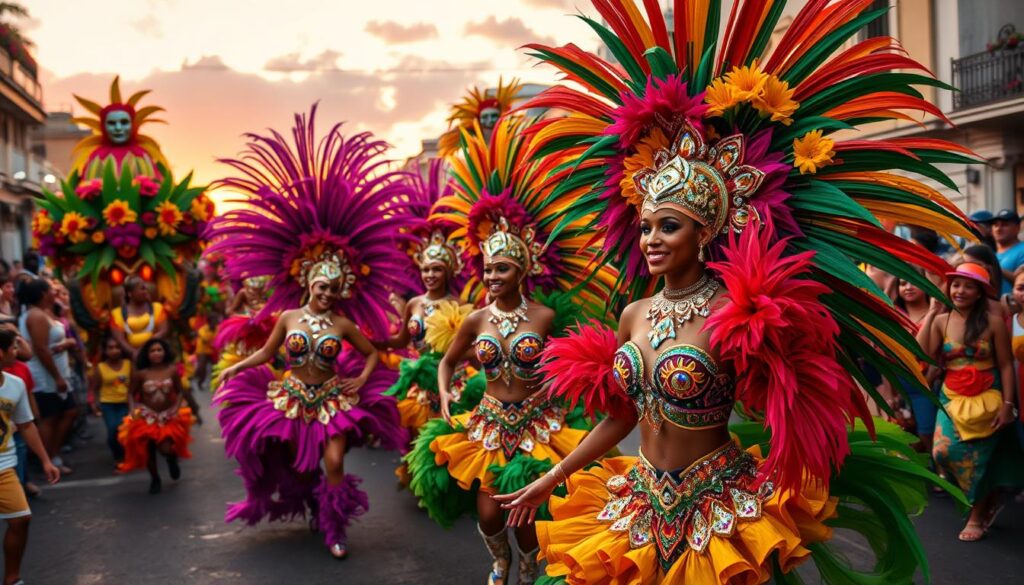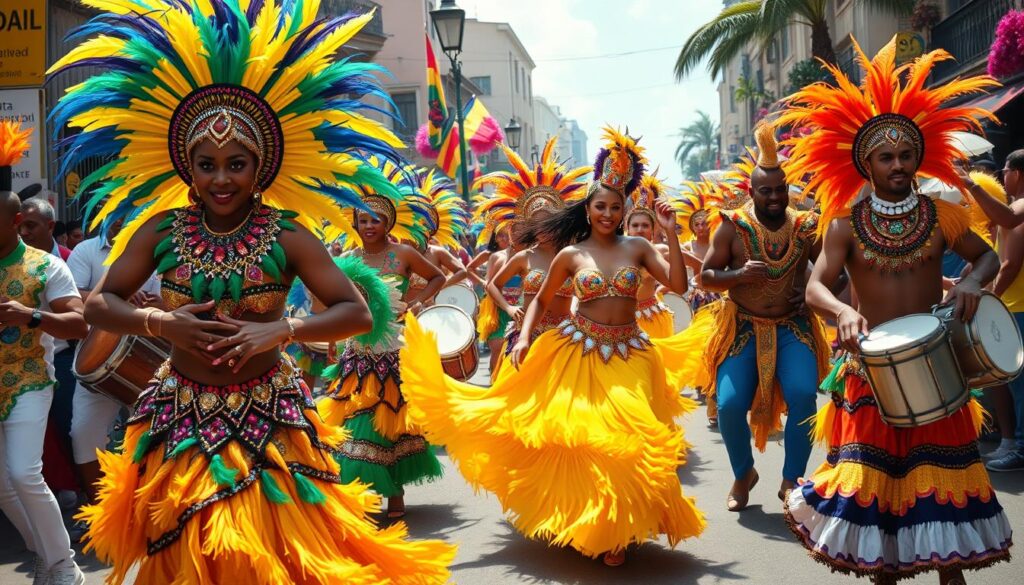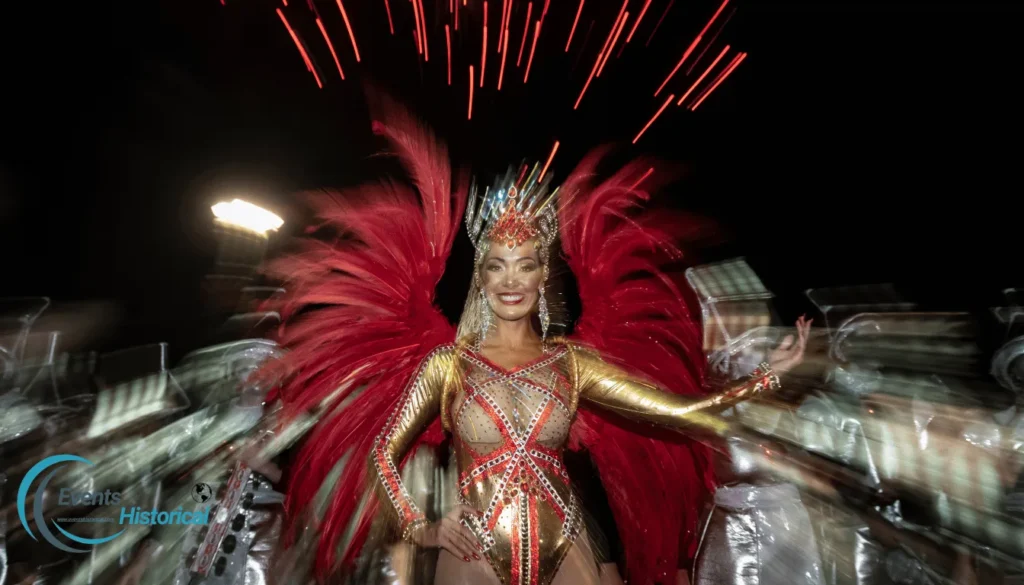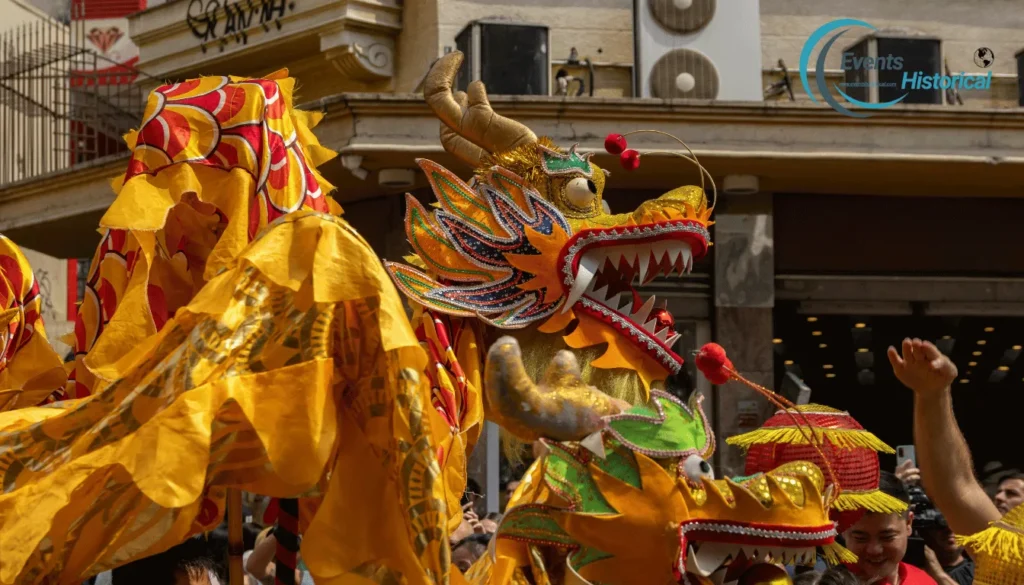Discover Brazil’s Carnival, a vibrant celebration of music, dance, and tradition. Experience colorful parades, samba rhythms, and the rich heritage of this iconic festival.
Ever wondered what it’s like to dive into the world’s biggest and most colorful carnival? The Carnival in Brazil is more than just a festival; it’s a deep dive into Brazilian culture, music, and traditions. But what makes this event so special and sought-after by millions worldwide? Let’s explore the heart of the Carnival in Brazil and why it’s a top experience for travelers.

Key Takeaways
- Carnival in Brazil is a vibrant, annual celebration leading up to Lent, ending on the Tuesday before Ash Wednesday.
- The dates of Carnival vary each year, but it generally takes place in February or early March.
- Carnival features elaborate parades, street parties, and samba school competitions that showcase the country’s rich musical and cultural heritage.
- The Carnival celebration attracts millions of visitors to Brazil, creating a multi-million dollar industry and numerous indirect jobs.
- Beyond Rio, other Brazilian cities like Recife, Olinda, and Salvador also host vibrant Carnival celebrations with their own unique traditions and customs.
The Essence of Brazil Carnival: A Cultural Celebration of Music and Dance
Samba Rhythms and Parades: The Heartbeat of Brazil Carnival Cultural Celebration
The Brazilian Carnival is all about the lively samba rhythms and the amazing elaborate parades. Samba, with its Afro-Brazilian roots, is the main attraction. It draws in both locals and tourists with its lively energy and catchy beats.
Months of hard work lead up to the samba parades in places like the famous Sambódromo in Rio de Janeiro. Elaborate floats with stunning designs and themes show off each samba school’s creativity and hard work.
The parades are a treat for the eyes, with carnival dancers in fancy costumes dancing in perfect sync with the samba music. These parades bring people together, showing the power of inclusivity and shared cultural significance.
“The Brazilian Carnival commences on February 9th and concludes on February 17th, 2024.”
The performances mix Afro-Brazilian traditions with dance, music, and spirituality. This makes them a colorful display of Brazil’s rich heritage.

Blocos – Street Parties of Joy
The carnival blocos, or street parties, show the joy and inclusiveness of Brazilian carnival. These lively events bring people together, creating a fun atmosphere. They are filled with carnival music and dance and colorful costumes.
Unlike the planned samba parades, blocos are spontaneous. They turn ordinary streets into dance floors.
The neighborhood pride in blocos brings people together. Locals and visitors join in the fun. The streets are filled with music, dance, and the smells of Brazilian street food and drink.
These inclusive celebrations are huge and popular. The biggest bloco, Cordão do Bola Preta, has over 200,000 people. Simpatia é Quase Amor gets about 100,000, and Monobloco can have up to 80,000 on Copacabana Beach.
The Banda de Ipanema bloco is a hit with the LGBTQ+ community. It draws around 30,000 people over three days.
Rio Carnival has grown from traditional cordões to modern blocos. This shows the city’s rich culture and love for music and dance. These street parties are free, welcoming millions each year.
| Bloco Name | Estimated Attendance | Notable Features |
|---|---|---|
| Cordão do Bola Preta | Over 200,000 | One of the largest blocos in Rio |
| Simpatia é Quase Amor | Approximately 100,000 | Attracts a large crowd to its carnival celebration |
| Monobloco | Up to 80,000 | Hosts its party on Copacabana Beach |
| Banda de Ipanema | Around 30,000 | Especially popular with the LGBTQ+ community |

These street parties show the spirit of Brazilian carnival. They are full of inclusive celebrations and spontaneous revelry. They display carnival music and dance, colorful costumes, and neighborhood pride.
Captivating Costumes and Masks
The Brazilian Carnival is a dazzling spectacle of vibrant colors and intricate designs. These are seen in the captivating costumes and masks worn by participants. These elaborate ensembles are not just clothes; they are masterful works of art.
At the heart of the carnival’s splendor are the costumes made by skilled artisans. They spend months on each costume, from picking and dyeing feathers to sewing on sequins and beads. Each detail is carefully thought out to bring the chosen themes to life.
Over time, carnival costumes have grown from simple to extravagant. This shows the incredible creativity and craftsmanship of the Brazilian people.
Expressive Artistry and Cultural Symbolism
Beyond their beauty, carnival costumes express Brazil’s rich cultural heritage. They draw from indigenous traditions, Afro-Brazilian rituals, and colonial history. Color symbolism is key, with each color representing different parts of Brazilian identity.
The idea of “fantasia,” or fantasy, is central to the carnival’s costume culture. Participants get to transform into fantastical characters, mythical beings, or historical figures. Masks add mystery and allure, often enhancing the costume’s design.
The impact of these costumes and masks goes beyond the carnival. They attract tourists, boosting the economy and creating jobs. As the carnival evolves, these costumes and masks remain a symbol of Brazilian identity.
Carnival in Brazil: A Vibrant Cultural Celebration of Music, Dance & Tradition
The Brazilian Carnival is a showcase of the nation’s rich culture. It features music, dance, and community traditions. The Carnival spirit fills the country, drawing in both locals and visitors.
Samba’s beats are matched by samba dancers who wow the crowds. People wear outrageous costumes, adding to the fun.
The Carnival brings people together, showing the nation’s unity. It’s a time of joy, with samba dancers and bands filling the streets. They celebrate the cultural heritage with passion.
The Carnival has a long history, starting in the 18th century. In the 1930s, Rio de Janeiro made it official. Samba music became popular in the early 20th century.
The Carnival happens in February or March, before Lent. It draws around 4 million people each year.
Floats up to 15 meters tall are part of the parade. In Rio de Janeiro, 2 million people join in. Schools like Mangueira and Salgueiro prepare for months.
The Samba parade is a highlight, with schools competing. Celebrities like Anitta add to the excitement. Each school focuses on social issues and cultural themes.
The brazilian carnival celebration celebrates the nation’s music and dance traditions and cultural heritage. It’s a time of inclusive celebrations and collective joy.
Regional Highlights: Beyond Rio
Rio de Janeiro’s Carnival is famous, but other cities in Brazil have their own amazing Carnivals. Discover the diverse regional highlights that offer unique experiences beyond Rio.

Carnival in Buzios turns a beautiful beach town into a party spot. It has lively bars, restaurants, and nightclubs. The village of Porto de Galinhas in Pernambuco offers Afro-Brazilian Carnival celebrations. It’s great for dining, nightlife, and water sports.
Porto Seguro has a top Carnival celebration, second to Rio and Salvador. It features massive floats, live bands, and samba dancers. Jericoacoara Beach is a surfer’s dream. It has a lively nightlife along the beach and many places to stay.
Iguazu Falls is a natural wonder perfect for a unique Carnival. It offers adventure sports and the Carnival’s energy.
| Carnival Destination | Highlights |
|---|---|
| Buzios | Vibrant bars, restaurants, and nightclubs along the pristine coastline |
| Porto de Galinhas | Afro-Brazilian-infused Carnival celebrations, excellent dining, and water sports |
| Porto Seguro | One of the best weeklong Carnival celebrations in Brazil, with massive floats and live music |
| Jericoacoara Beach | Carnival festivities along the beach, with a variety of accommodation options |
| Iguazu Falls | Opportunity to experience the Carnival’s energy while enjoying adventure sports and the natural wonder |
“Carnival in Brazil is not just a celebration; it’s a way of life, a vibrant expression of the country’s rich cultural heritage.”
Sustainable Celebrations
The Brazilian Carnival is known for its vibrant colors and lively music. But now, there’s a push for making it more eco-friendly. This way, we can enjoy the culture while being kind to the planet.
Eco-Friendly Efforts and Community Engagement
In Brazil, samba schools and local groups are taking steps to make Carnival better for the environment. They’re using materials that break down easily, setting up recycling systems, and getting everyone involved in the fun.
- Samba schools are choosing fabrics and materials that are good for the planet. They’re also using lights that don’t waste energy.
- Places like the Sambadrome in Rio de Janeiro have recycling programs. This helps cut down on trash and makes the celebration greener.
- People from the community are helping plan and carry out the Carnival. This makes them feel more connected and committed to keeping it green.
By working together and using green practices, the sustainable carnival celebrations in Brazil are changing. They’re becoming a celebration that’s good for the environment and keeps the culture alive.
| Sustainable Carnival Initiatives | Impact |
|---|---|
| Use of biodegradable materials in costumes and floats | Reduced waste and environmental impact |
| Comprehensive recycling programs at Carnival venues | Increased waste management and recycling rates |
| Community engagement in Carnival planning and execution | Increased ownership and long-term commitment to sustainability |
By taking on these eco-friendly carnival projects, the Brazilian Carnival is showing us how to do it right. It’s all about community engagement in carnival and responsible carnival practices. This can inspire other celebrations to follow suit and care for our planet.
Planning Your Carnival Adventure
Going to the Brazilian Carnival needs careful planning for a great time. Make sure to book your carnival tickets and reservations early. This is because popular spots and hotels in Rio de Janeiro and Salvador fill up fast.

Choosing where to stay is also key. The big crowd during Carnival makes finding rooms hard. It’s best to book 4-6 months ahead to get the best deals.
- The Rio de Janeiro Samba Parade tickets, specially the best seats, sell out quickly. So, book around 6 months in advance.
- If you want to join the Rio parade, plan extra time for getting costumes and practice.
Don’t forget about carnival safety tips. Leave valuable items at home and use taxis or rideshares at night. This keeps you safe during the fun.
Also, pack the right carnival packing list. Wear comfy, easy-to-clean clothes and good shoes. The carnival is lively and can be tiring.
“With the right preparation and mindset, travelers can fully immerse themselves in the Carnival’s infectious energy and create lasting memories of this cultural extravaganza.”
Plan your carnival in Brazil trip early. This way, you can dive into the festival’s spirit and make memories that last a lifetime.
| Carnival Location | Annual Attendance | Key Highlights |
|---|---|---|
| Rio de Janeiro | Over 1.5 million tourists | World-class parade in the Sambodrome, lively street parties (blocos) |
| Salvador | Around 800,000 visitors | Blend of samba, reggae, and samba-reggae music |
| São Paulo | N/A | Carnival parade in the Anhembi Sambodrome with elaborate floats and costumes |
| Recife | 2,500,000 participants in Galo da Madrugada parade | Holds the Guinness World Record for the biggest carnival parade |
| Rio de Janeiro (Blocos) | Up to 1 million participants | Lively street parties with a wide range of attendees |
Culinary Delights of Carnival
The Brazilian Carnival is more than just music and dance. It’s a feast for the senses. The streets buzz with samba rhythms and the air is filled with the smells of carnival food and drink. It’s a culinary journey like no other.
At the heart of the traditional brazilian carnival dishes are iconic favorites. Feijoada, a hearty black bean stew, brings people together. Another favorite, coxinha, is a deep-fried pastry filled with chicken and cheese. It’s a satisfying treat with every bite.
The brazilian cuisine during carnival also offers sweet treats. Try the crispy, sugar-dusted chiacchiere of Italy or the creamy frittelle filled with raisins and pine nuts. Both are carnival delicacies that capture the spirit of the festivities.
| Carnival Dish | Country | Description |
|---|---|---|
| Feijoada | Brazil | A hearty black bean stew that brings people together in a communal celebration. |
| Coxinha | Brazil | A deep-fried pastry filled with shredded chicken and cheese, providing a satisfying crunch. |
| Chiacchiere | Italy | Crispy, sugar-dusted fried pastries enjoyed during Carnevale celebrations. |
| Frittelle | Italy | Small doughnuts filled with raisins and pine nuts or cream, adding to the festive indulgence. |
Exploring the carnival food and drink scene deepens your understanding of the Brazilian Carnival. It’s a way to truly experience the rich culture of this vibrant celebration.
Carnival Traditions Beyond Brazil
The Brazilian Carnival is famous for its grandeur and cultural importance. But, carnival celebrations are not just in Brazil. Countries worldwide, from the Caribbean to Europe, have their own carnival traditions. These share a spirit of fun, music, and cultural expression.
Mardi Gras in the United States, mainly in New Orleans, is a big deal. It’s known for its colorful costumes, lively parades, and the famous King Cake. In Italy, Venice’s Carnival is celebrated with fancy masks and costumes. It takes people back to the city’s rich history.
In the Caribbean, places like Trinidad and Tobago, Bahamas, and Jamaica also celebrate carnival. Each has its own unique culture and traditions. These celebrations mix African, European, and indigenous influences, showing the area’s diversity.
- Carnival in Trinidad and Tobago is famous for its bright costumes, energetic steel drum music, and Jouvert celebration.
- The Bahamas Junkanoo Carnival has colorful costumes and a lively parade in Nassau’s streets.
- Jamaica’s Carnival, or “Bacchanal,” combines reggae, dancehall, and soca music with vibrant costumes and fun celebrations.
These international carnival festivals show how carnival traditions connect people. They highlight the joy of cultural exchange and the importance of community and tradition.
“Carnival is a time when the world is turned upside down, when social hierarchies are suspended, when everyone can be someone else.”
Conclusion
The Brazilian Carnival is a vibrant celebration that goes beyond time and borders. It’s filled with music, dance, and tradition. The Carnival shows off Brazil’s diverse heritage and the joy of coming together.
Attending the grand parades in Rio or enjoying the street parties is unforgettable. The Carnival leaves a lasting mark on everyone who experiences it. It keeps growing, adding sustainable practices and community involvement. This shows the Brazilian people’s resilience and creativity.
The Carnival is a key part of Brazilian culture, showing the nation’s diversity and spirit. By diving into the Carnival, people can feel the unique rhythms, colors, and traditions. It’s an experience like no other.
FAQ
What is the Brazilian Carnival?
The Brazilian Carnival is an annual festival before Lent. It’s a colorful celebration in Brazil. People prepare for months with parades, street parties, music, dance, and fancy costumes.
When does the Brazilian Carnival take place?
The Brazilian Carnival’s dates change each year, like Easter. It usually happens in February or early March, before Ash Wednesday.
What are the key elements of the Brazilian Carnival?
The Carnival focuses on samba rhythms and parades. These parades, called “samba parades,” feature floats and dancers in detailed costumes. Street parties, or “blocos,” also happen, where people come together to celebrate.
What is the significance of the costumes and masks in the Brazilian Carnival?
The costumes and masks are like art, adding magic to the Carnival. They show Brazil’s rich culture, blending indigenous, Afro-Brazilian, and colonial traditions.
Is the Brazilian Carnival only celebrated in Rio de Janeiro?
While Rio is famous for Carnival, other cities like Buzios and Porto de Galinhas also celebrate. Each city brings its own unique flair to the festivities.
How can travelers plan their Brazilian Carnival experience?
Planning ahead is key for Carnival. Book tickets and places to stay early. Wear comfy clothes and shoes that are easy to clean.
Is the Brazilian Carnival taking steps towards sustainability?
Yes, Carnival is becoming more eco-friendly. Samba schools and communities are working to reduce waste and protect the environment.
What are some of the culinary delights associated with the Brazilian Carnival?
Carnival offers a wide range of food. Street vendors serve traditional dishes and local treats. It’s a chance to try Brazil’s flavors while celebrating.
Are there Carnival traditions celebrated outside of Brazil?
Yes, Carnival is celebrated worldwide. Countries like the United States, Italy, and Trinidad and Tobago have their own Carnival traditions. They share the joy of music and culture.

